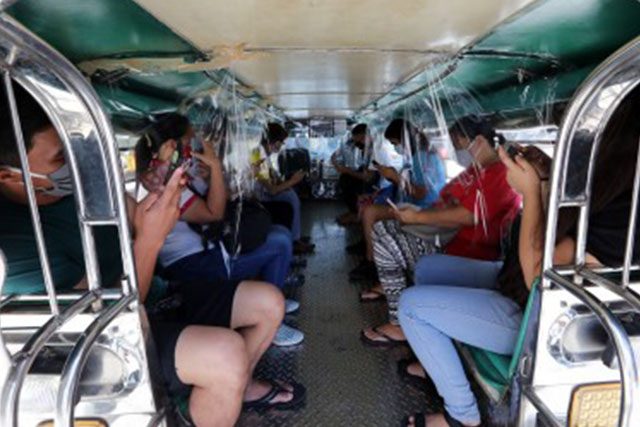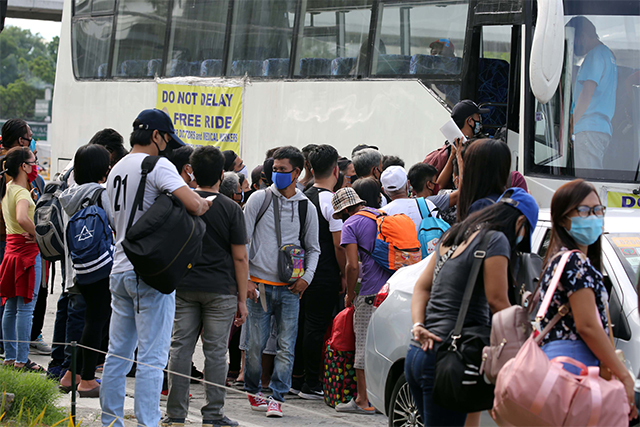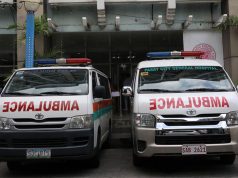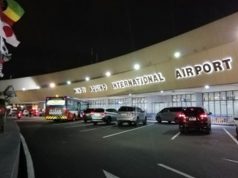
Government agencies were accused of supposedly placing the “burden” on commuters in terms of practicing health and safety protocols after the transportation department announced that the public can now be less than a meter away from each other in mass transport.
Following this new directive, the Department of Health enjoined Filipinos “to be extra vigilant in situations where distancing cannot be practiced” and to choose other transport options “that can afford at least 1 meter distancing.”
It also reiterated the consistent observance of minimum health protocols such as the wearing of face masks and face shields, handwashing and the maintaining of physical distancing in the public.
The DOH’s statement came after the Department of Transportation said distance between passengers is now reduced to 0.75 from one meter. This will be enforced to commuters in mass transport such as trains, public utility vehicles, buses and jeepneys starting Monday, September 14.
Distance among these passengers will eventually be eased to 0.5 meters by September 28 and 0.3 meters on October 12.
Minimum health and safety protocols such as the wearing of face masks and face shields, the non-talking and no answering of phone calls inside mass transport to avoid the transmission of respiratory droplets, will still be imposed.
The DOTr said that the new physical distancing rule was enforced “to increase ridership in public transportation” in response to “grievances” about the lack of public transportation available, as well as to help revitalize the economy.
“The DOTr has heard and is responding to the clamor of the people that public transport be opened up since there are more people going out of their homes to earn. We are balancing the interest of the people. We are adding more passengers to help the economy recover,” it said on Monday.
The protocols are “subject to changes should there be any concern after the implementation,” the transport agency added.
Transport Undersecretary Timothy John Batan said that the DOTr made a survey of other countries’ health protocols on public transport and found out that many have relaxed their measures while retaining other guidelines like the wearing of face masks.
This was reiterated by another DOTr official, Undersecretary Artemio Tuazon, who cited medical experts and said the wearing of face masks and face shields, coupled with regular disinfection, can still decrease the virus’ transmission rate.
‘Kanya-kanya’
Meanwhile, some Filipinos were not too keen of the two agency’s statements on the relaxation of physical distancing measures as the country continues to battle the novel coronavirus pandemic.
Health reform advocate Dr. Tony Leachon, who is also a former special adviser to the National Task Force Against COVID-19, believed that the DOH’s statement about DOTr’s guidelines was “weak, confusing and arbitrary.”
“There’s no categorical statement from DOH to oppose the DOTr on these flawed public transport guidelines,” he tweeted in response to DOH’s statement on the matter.
Physician and columnist Gideon Lasco likewise said that the easing of distancing measures is “another example of the gov’t placing the burden on individuals instead of building a safe environment.”

“It is also another example of inequity: Those who can’t afford private transport are exposed to the harshest policies,” Lasco added in response to DOH’s statement that people who can afford other transport options may opt for those instead.
“So ganoon na lang, kanya-kanyang ingat na lang? Walang konsensya. Pinapasweldo ng taumbayan para lang makipagsabwatan sa interes ng negosyante. Para saan ang ekonomiya kung libo-libo ang mamamatay? Para saan pa ang pagiging eksperto niyo?” another Twitter user asked DOH.
“Napaka-inutil naman ng @DOHgovph. Sino ba ang lead agency ng IATF (Inter-Agency Task Force for the Management of Emerging Infectious Disease)? Sino ba ang lead agency for health standards? Easing the distancing measures is against WHO standards. Tapos ang sasabihin lang ng DOH, ‘be extra vigilant,’ shuta mamamatay na lang tayo lahat,” wrote another online user.
A Twitter user suggested for the government to “increase the PUVs” and implement “faster transit time for the MRT/LRT coaches” instead of reducing the physical distance between passengers.
The Healthcare Professionals Alliance Against COVID-19 also expressed concerns about the easing of physical distance and was reported to be in talks with the government about the policy.
“Hindi kami sang-ayon dito. Pero patuloy kaming nakikipagusap sa pamahalaan,” HPACC spokesperson Dr. Antonio Dans was quoted by reports as saying.
“‘Pag titingnan natin ang curve ng pandemic na ito, masyadong maaga pa. Malamang na dumami lalo ang kaso at bumagal ang recovery natin kung gawin natin ito ngayon,” he said.
The same group last month asked President Rodrigo Duterte to temporarily place the National Capital Region under enhanced community quarantine to lessen the burden of healthcare workers amid rising cases before.
The DOTr on Monday said that the new mass transport guidelines had the DOH’s “approval” and reiterated that the “no talking” and no taking calls” policies will be implemented to reduce transmission of respiratory droplets.
The management of MRT-3, LRT-1 and LRT-2 has previously prohibited the passengers from talking in trains.
Transportation Assistant Secretary Mark Steve Pastor said that passengers will be asked to fill out forms for contact tracing. There would also be security marshals who will monitor health protocols in public transport.
The World Health Organization recommends the public to stay at least one meter away from each other to reduce the risk of potentially transmitting respiratory droplets that may contain the virus, which is produced while talking, coughing, shouting and singing.
One meter is nearly equivalent to a motorcycle’s length.
COVID-19 is primarily spread through respiratory droplets that are airborne in enclosed indoor settings with poor ventilation or those with recirculated air.
Strictly practicing physical distancing measures is one of the means in mitigating the spread of the pathogen which has a high transmission rate.
Experts said that observing such a preventive measure is crucial for “flattening the curve” or significantly reducing the number of infections in a community so that the health care system wouldn’t be burdened.
Malacañang previously said that maintaining physical distance will be a huge part of the “new normal” while a vaccine is not yet publicly available against the viral disease.
On Monday, presidential spokesperson Harry Roque said that the IATF will hold a meeting to discuss the new physical distancing measure following concerns from the public and medical experts.









